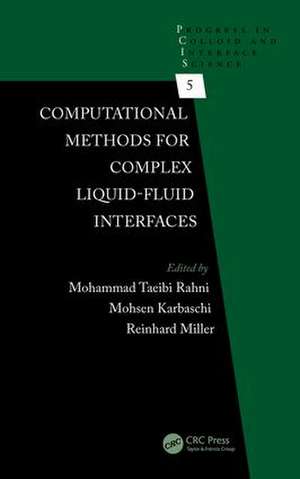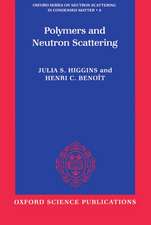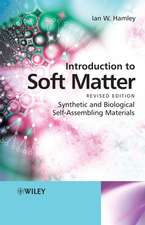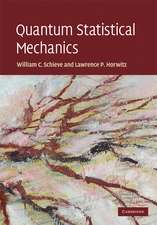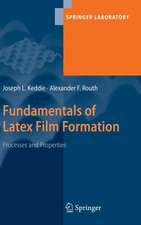Computational Methods for Complex Liquid-Fluid Interfaces: Progress in Colloid and Interface Science
Editat de Mohammad Taeibi Rahni, Mohsen Karbaschi, Reinhard Milleren Limba Engleză Hardback – 2 dec 2015
- defines the most important interfacial quantities and their experimental investigations, providing theoretical background and detailed solutions,
- describes vital techniques used in interfacial flow problems, such as modern meshless numerical methods and conventional computational fluid dynamics methods, and
- discusses the technicalities of correctly using the computational methods developed for interfacial flows, as well as the simulation of interesting interfacial flow physics.
Edited and authored by leading scientists and researchers, Computational Methods for Complex Liquid-Fluid Interfaces offers an authoritative and state-of-the-art overview of computational methodologies and simulation techniques for the quantification of interfacial quantities.
| Toate formatele și edițiile | Preț | Express |
|---|---|---|
| Paperback (1) | 481.67 lei 6-8 săpt. | |
| CRC Press – 29 oct 2019 | 481.67 lei 6-8 săpt. | |
| Hardback (1) | 1373.34 lei 6-8 săpt. | |
| CRC Press – 2 dec 2015 | 1373.34 lei 6-8 săpt. |
Preț: 1373.34 lei
Preț vechi: 1674.80 lei
-18% Nou
Puncte Express: 2060
Preț estimativ în valută:
262.82€ • 273.38$ • 216.97£
262.82€ • 273.38$ • 216.97£
Carte tipărită la comandă
Livrare economică 14-28 aprilie
Preluare comenzi: 021 569.72.76
Specificații
ISBN-13: 9781498722087
ISBN-10: 1498722083
Pagini: 556
Dimensiuni: 178 x 254 x 36 mm
Greutate: 3.35 kg
Ediția:1
Editura: CRC Press
Colecția CRC Press
Seria Progress in Colloid and Interface Science
ISBN-10: 1498722083
Pagini: 556
Dimensiuni: 178 x 254 x 36 mm
Greutate: 3.35 kg
Ediția:1
Editura: CRC Press
Colecția CRC Press
Seria Progress in Colloid and Interface Science
Public țintă
Professional Practice & DevelopmentCuprins
Thermodynamics of Adsorption at Liquid Interfaces. Nonequilibrium Thermodynamics of Interfaces. Experimental Approaches and Related Theories. Dynamics of Interfacial Layer Formation. Model-Based Computational Approaches to Analyze Interfacial Problems. Molecular-Scale Computational Techniques in Interfacial Science. Mesoscale Computational Techniques in Interfacial Science: Lattice Boltzmann Method. Mesoscale Computational Techniques in Interfacial Science: Smoothed Particle Hydrodynamics Method. Macroscale Computational Techniques in Interfacial Science. Computational Quantum Chemistry Applied to Monolayer Formation at Gas/Liquid Interfaces. Molecular Dynamics Simulation of Surfactant Monolayers. Molecular Dynamics Simulation of Droplet Spreading and Wettability Issues. Implementation of Immersed Boundary Method to Study Interactions of Fluids with Particles, Bubbles, and Drops. Mesoscale Lattice Boltzmann Model of Dispersions Stabilized by Surfactants. Hybrid Numerical Method for Interfacial Flow with Soluble Surfactant and Its Application to an Experiment in Microfluidic Tip Streaming. Finite Element Computations for Dynamic Liquid–Fluid Interfaces. Finite Element Techniques for the Numerical Simulation of Two-Phase Flows with Mass Transport. Finite Volume/Finite Area Interface-Tracking Method for Two-Phase Flows with Fluid Interfaces Influenced by Surfactant. Approximate Analytical Solution via ADM and Numerical Simulation of Acoustic Cavitation: Bubble Dynamics. Numerical Solution, Stability, and Control of Acoustic Cavitation-Bubble Dynamics. Liquid Bridge and Drop Transfer between Surfaces. Solutal Marangoni Convection: Challenges in Fluid Dynamics with Mass Transfer. Hierarchical Marangoni Roll Cells: Experiments and Direct Numerical Simulations in Three and Two Dimensions. Modeling Foam Stability.
Notă biografică
Mohammad Taeibi Rahni received both his B.Sc and M.Sc from the University of Texas at Austin, USA, and his Ph.D from the University of Illinois, Urbana-Champaign, USA. He is a guest researcher at the Max Planck Institute of Colloids and Interfaces in Potsdam, Germany, and has a full-time appointment with Sharif University of Technology, Tehran, Iran. His main area of interest is computational fluid dynamics, with particular emphasis on the application of various computational techniques to interfacial phenomena.
Mohsen Karbaschi earned his Ph.D in chemical engineering from Sharif University of Technology, Tehran, Iran, linked to the Max Planck Institute of Colloids and Interfaces in Potsdam, Germany. He has worked as a researcher at the Max Planck Institute of Colloids and Interfaces since 2011. His primary research interests lie in the area of surface science and multiphase flows, particularly with respect to computational fluid dynamics simulations and experimental analysis.
Reinhard Miller studied mathematics at the University of Rostock, Germany, and did his Ph.D and habilitation at the Berlin Academy of Sciences, Germany. He currently works at the Max Planck Institute of Colloids and Interfaces in Potsdam, Germany. His scientific interests are experimental investigations of adsorption layers at liquid interfaces under dynamic conditions, interfacial rheology, stability of foams, and emulsions.
Mohsen Karbaschi earned his Ph.D in chemical engineering from Sharif University of Technology, Tehran, Iran, linked to the Max Planck Institute of Colloids and Interfaces in Potsdam, Germany. He has worked as a researcher at the Max Planck Institute of Colloids and Interfaces since 2011. His primary research interests lie in the area of surface science and multiphase flows, particularly with respect to computational fluid dynamics simulations and experimental analysis.
Reinhard Miller studied mathematics at the University of Rostock, Germany, and did his Ph.D and habilitation at the Berlin Academy of Sciences, Germany. He currently works at the Max Planck Institute of Colloids and Interfaces in Potsdam, Germany. His scientific interests are experimental investigations of adsorption layers at liquid interfaces under dynamic conditions, interfacial rheology, stability of foams, and emulsions.
Descriere
This book highlights key computational challenges involved in the two-way coupling of complex liquid-fluid interfaces. Including pivotal applications as examples, the text defines the most important interfacial quantities and their experimental investigations, providing theoretical background and detailed solutions. It describes vital techniques used in interfacial flow problems, such as modern meshless numerical methods and conventional computational fluid dynamics methods. The book also discusses the technicalities of correctly using the computational methods developed for interfacial flows, as well as the simulation of interesting interfacial flow physics.
